
### Beautiful and Ugly Theories: The Intersection of Einstein’s General Relativity and Milgrom’s MOND
The realm of theoretical physics is one where perceptions of truth are often influenced by notions of beauty and elegance. Although empirical accuracy is the ultimate authority in science, physicists frequently lean toward “beautiful” theories—those defined by simplicity, symmetry, and the power to conceptualize the universe deeply. But how should we regard the “ugly” theories? Do they merit consideration, even when yielding predictions as precise as their more elegant peers? The contrast between Einstein’s **General Relativity (GR)** and Mordehai Milgrom’s **MOdified Newtonian Dynamics (MOND)** serves as a valuable case of the tension between beauty and practicality in scientific inquiry.
—
### The Appeal of General Relativity
Albert Einstein’s **General Relativity** is widely recognized as a foundational element of contemporary physics—and an extremely beautiful theory. Fundamentally, GR depicts gravity not as a conventional “force” as understood in Newtonian mechanics, but rather as the curvature of spacetime induced by energy (which encompasses mass, momentum, and pressure). Mathematically, GR is remarkably elegant, succinctly represented by Einstein’s renowned field equations:
> ( G_{munu} + Lambda g_{munu} = frac{8pi G}{c^4} T_{munu} )
This seemingly simple equation conveys a vast amount of complexity, detailing how matter and energy shape the curvature of spacetime, which subsequently governs the motion of objects.
GR possesses significant explanatory capability. It anticipated phenomena such as the bending of light around massive bodies (gravitational lensing), the precise trajectory of Mercury’s orbit, gravitational time dilation, and notably—gravitational waves, which were directly detected a century post-prediction. The profound understanding GR offers into the workings of the universe has fascinated physicists for ages.
Yet, beneath its beauty, a significant challenge exists. The mathematics underlying GR is extraordinarily intricate, often necessitating that solutions depend on assumptions about symmetry or numerical methods. Explicit solutions to its equations emerge only in exceptional instances. This complexity has not diminished GR’s allure—if anything, it has added to its charm, allowing physicists to delve into its complexities indefinitely.
—
### The “Ugliness” of MOND
Conversely, **MOND** lacks the aesthetic charm that characterizes GR. Introduced by Israeli physicist Mordehai Milgrom in the early 1980s, MOND does not stem from any profound philosophical or geometric insights into the universe. Instead, it is an empirical adjustment of Newton’s gravitational law formulated to solve one particular issue: the unexplained motions of stars and galaxies.
When applying Newtonian gravity to galaxies, one would expect the observed rotational velocities of stars to diminish with distance from the galactic center, as dictated by the inverse-square law ((1/r^2)). However, empirical observations reveal that galaxy rotation curves remain flat—the stars at the edges orbit at the same velocity as those closer to the center. To reconcile this discrepancy, astrophysicists suggested the existence of **dark matter**, an unseen, non-baryonic matter that contributes additional gravitational influence.
MOND takes an alternative route. Rather than hypothesizing dark matter, it adjusts Newton’s laws to introduce an extra term. At very low accelerations, gravity no longer decreases as (1/r^2) but shifts smoothly to a reduced (1/r) dependence. Formally, MOND establishes a characteristic acceleration scale, (a_0), below which this alteration becomes significant. Its equations are relatively straightforward and do not necessitate the presence of unseen components like dark matter.
The drawback of MOND is its absence of theoretical foundations. It does not emerge from any fundamental principles but rather constitutes a makeshift remedy designed to align with observed data. Consequently, MOND is considered quite “ugly” by the standards of theoretical physics. It is functional but lacks motivation—an empirical fix devoid of any conceptual refinement.
—
### MOND vs. GR in Application
In most practical scenarios, MOND and GR yield the same predictions. This is because MOND’s modifications to gravity only manifest in contexts of very low acceleration, such as at the edges of galaxies. Locally—on Earth, within the solar system, and even in dense star systems—MOND operates identically to Newtonian gravity, which is encompassed by GR. Accordingly, MOND remained largely an anomaly during its early years, overlooked by many physicists in favor of GR, which elegantly integrates both Newtonian mechanics and relativistic effects.
Another aspect adding to MOND’s obscurity is its inability to seamlessly harmonize with other successful physical theories. While GR functionally coexists with other fundamental theories (albeit facing substantial hurdles in unifying it with quantum mechanics), MOND exists as an isolated framework.